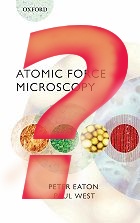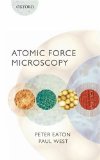 Test for Chapter 1 - Introduction
Test for Chapter 1 - Introduction
Chapter 1 is the introduction chapter. Firstly the background to AFM is explained, which techniques preceded it, and how it came to be invented. Then some important characteristics of AFM are discussed, with reference to other microscopy techniques. This is a short chapter, covering briefly some material that occurs in greater details through the rest of the book; for this reason there are only 5 questions here.
Q1. What two major instruments preceded AFM?
Q2. Who invented the AFM and built the first ever instrument?
Q3. Which SPM technique is most commonly used, STM or AFM?
Q4. Which prize was given to the inventors of AFM and why?
Q5. Limitation in imaging what kind of sample limitation lead to the development of the AFM?
Long answer question.
Compare SEM, TEM with AFM. Under what circumstance would AFM be better than SEM, TEM and optical microscopy? Under what circumstance would AFM be worse than SEM, TEM and optical microscopy?
This email address is being protected from spambots. You need JavaScript enabled to view it.
- Details
- Hits: 30189
This page has resources to help use the book "Atomic Force Microscopy" for learning and teaching about AFM.
AFM QUIZZES
Here are some quizzes based on the chapters in the book.
- The first quiz is based on Chapter 1 - the introduction to AFM.

Chapter 1: Introduction to AFM Quiz
- The second quiz is based on chapter 2, which is all about AFM instrumentation, and describes in detail how AFM instruments work:
Chapter 2: AFM Instrumentation Quiz
- The third quiz is all about the different modes and experiments available in AFM:
- The fourth quiz covers the chapter on practical aspects of acquiring AFM images and other data:
Chapter 4: Measuring AFM Images Quiz
- The fifth quiz is about processing, analysis and display of AFM data:
Chapter 5: Processing AFM Images Quiz
- The sixth and last quiz is about artifacts in AFM images.
AFM COURSES
I regularly teach AFM courses, which typically feature a mix of lectures and hands-on classes. When there are open classes, they will be announced on the front page of this website. The recurring course in Porto, the Porto AFM Workshop (formerly the Requimte AFM Workshop) is held annually in Porto, Portugal, and is described here.
AFM TEACHING RESOURCES
- AFM Poster - can be a useful aid to show how AFM works in your lab / classroom
- AFM slide - a simple slide showing a schematic of the workings of an AFM
I am happy to receive suggestions on other learning and teaching content that would be useful here, please feel free to This email address is being protected from spambots. You need JavaScript enabled to view it. for this!
- Details
- Hits: 37109
 Atomic Force Microscopy is now available to order from Amazon in the UK, see the link below.The book will arrive at amazon.com with some delay, since the shipping from the UK to the U.S. takes a while. You can also order from OUP direct, here.
Atomic Force Microscopy is now available to order from Amazon in the UK, see the link below.The book will arrive at amazon.com with some delay, since the shipping from the UK to the U.S. takes a while. You can also order from OUP direct, here.
This book is perfect for an introduction to AFM for new users, and I highly recommend it to researchers using the technique. It has lots of practical information on how to obtain AFM images, and also how to analyse and process the data. it also has an entire chapter devoted to what can go wrong with AFM, and how to avoid these problems! I believe it would also make an excellent coursebook, and some chapter quizzes will appear on this website soon. The quiz on the first chapter is already available here.
Click here to see Atomic Force Microscopy at Amazon.co.uk.

- Details
- Hits: 13618
 There is a freely-downloadable .pdf (4.8 MB file) of chapter 1 of my book, "Atomic Force Microscopy" available on the OUP web site. This has the preface and the whole of chapter 1.
There is a freely-downloadable .pdf (4.8 MB file) of chapter 1 of my book, "Atomic Force Microscopy" available on the OUP web site. This has the preface and the whole of chapter 1.This chapter contains background to AFM, and describes a few of the capabilities of the technique It explains how the technique was invented, and which instruments preceded it, and why AFM was needed. It also compares AFM to other microscopy techniques. The preface also contains information of the contents of the rest of the book.
The book should be published around 25th of March, pretty soon now!
- Details
- Hits: 47540
 I am adding quizzes based on each chapter, to enable a self-test check after you've read it, or to help in using the book in a course.
I am adding quizzes based on each chapter, to enable a self-test check after you've read it, or to help in using the book in a course.
The first quiz was a short one based on Chapter 1. Here's the quiz for chapter 2. Chapter 2 is all about AFM instruments. It describes how they are built, and why they are built that way. It details the function of each component in an AFM, and also describe AFM probes in detail. There are section on the AFM, stage, electronics, software, cantilevers and probes, the instrument environment, and the sample cell. This chapter is useful if you use AFM, since you can use the instrument better when you know how it works.
Chapter 2
Short Questions
- Details
- Hits: 25830
Subcategories
Page 11 of 21

